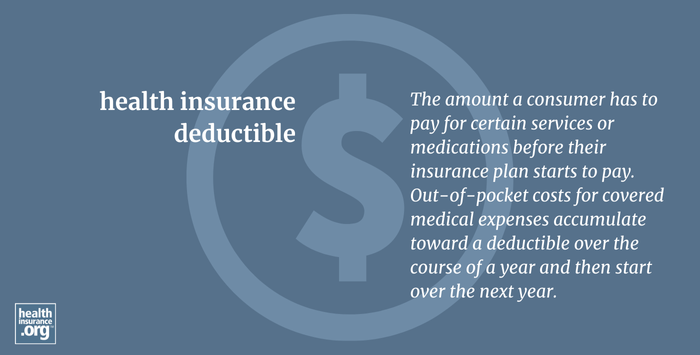
What is a health insurance deductible?
A health insurance deductible is the amount a consumer has to pay for covered services or medications before their insurance plan starts to pay. A deductible is a component of cost sharing. Covered medical expenses are added to or accumulated toward a deductible over the course of a year and then start over the next year. (Medicare Part A works differently, with deductibles that apply per benefit period rather than per year.)1
Once a policyholder meets their plan's deductible, most plan holders typically pay only a copayment or coinsurance for additional covered healthcare services or therapies used, up to an out-of-pocket maximum.
But under the Affordable Care Act, all non-grandfathered major medical plans have to cover certain preventive care with no cost-sharing, which means the insurer pays for these services even if the member has not met their deductible.2
Why do I have more than one deductible?
Health insurance plans may have multiple deductibles. For example, your policy may have both individual and family deductibles. Most plans also have a separate deductible if you use medical providers (doctors, hospitals, pharmacies, etc.) who are outside the plan's provider network, assuming the plan provides out-of-network coverage (many plans do not). Your deductible will generally be higher if you use an out-of-network provider. Your plan may also have separate deductibles for medical and prescription drug benefits.
If you switch plans part way through the year, you'll generally have to start over with a new deductible on your new plan. This is common, for example, if you leave a job where you had employer-sponsored health coverage, and switch to an individual market plan or a new employer's health plan mid-year.
How can I find out what my deductible will be?
Health plan websites or printed marketing materials provide deductible and other cost-sharing information. Don’t sign up for a plan without carefully reviewing all the terms of the coverage and comparing all costs (not only deductibles, but also premiums and copay/coinsurance amounts). If you or a dependent have a chronic illness, it may be more cost-effective for you to select a plan with a higher premium, but a lower deductible. On the other hand, if you know you're going to need a medical service that will cause you to meet the out-of-pocket maximum on any plan, it may be less costly overall to go with a higher deductible and lower premiums — different solutions work for different situations.
If you are eligible for Medicare, one helpful resource for comparing options is the Medicare Plan Finder tool.3 This plan comparison tool helps consumers compare all types of Medicare options (Medigap and Medicare Part D vs. Medicare Advantage coverage), including the cost of premiums and out-of-pocket expenses.
If you are comparing health plan options offered by your employer, your human resources department may point you to online tools that help compare plan options. These tools help consumers evaluate the types of healthcare services they might need over the plan year and help them choose a plan that makes the best financial sense for the employee and any dependents covered under the policy.
If you are buying insurance through the health insurance Marketplace/exchange, the federal exchange (HealthCare.gov) — or a state-run exchange if your state runs its own platform — will help you review the available options and compare their costs.
Once you've enrolled in a health plan, your ID card will typically have the deductible amount (and any copay amounts) printed on it for easy reference.
What is a typical deductible?
Deductibles can vary significantly from plan to plan. According to a KFF analysis, the 2024 average deductible for individual, employer-provided coverage was $1,787 ($2,575 at small companies vs. $1,538 at large companies).4
KFF also reported the average 2024 deductible for marketplace plans sold via HealthCare.gov, (combined for medical and prescription drugs) by metal rating: $7,258 for Bronze plans, $5,241 for Silver plans, $1,430 for Gold plans, and $97 for Platinum plans.5 But it should be noted that most Silver-plan enrollees are in plans that include cost-sharing reductions,6 with significantly lower deductibles than standard Silver plans.
How much are deductibles for high-deductible health plans?
High-deductible health plans (HDHPs) are a specific type of health plan that follows various IRS rules; it does not just refer to any health plan with a "high" deductible. For 2025, the IRS defines an HDHP as one with a minimum deductible of $1,650 for individual coverage or $3,300 for family coverage.7
HDHPs can have higher deductibles, although they're more limited than other plans in terms of total out-of-pocket caps: In 2025, an HDHP's maximum out-of-pocket can't exceed $8,300 for an individual or $16,600 for a family7 (versus $9,200 and $18,400 for other types of coverage).
What happens to my deductible if I switch plans?
If you switch plans mid-year — due to a job change, for example — you'll typically find that you start over with a new deductible on the new plan. It's possible for exceptions to be made if there are extenuating circumstances, such as an insurer becoming insolvent mid-year, or an insurer offering a deductible carry-over credit when a person switches to another plan offered by the same insurer. But exceptions like that are not common.
Deductibles are not prorated. So you'll still have a full deductible to meet for the remainder of the plan year before you receive post-deductible benefits, even if you join the plan mid-way through the plan year.
Footnotes
- "Medicare Part A ‘hospital insurance’ – coverage of inpatient care" Medicareresources.org. Nov. 11, 2024. ⤶
- "Preventive health services" Healthcare.gov. ⤶
- "Explore your Medicare coverage options" Medicare.gov. ⤶
- ”Employer Health Benefits, 2024 Annual Survey” KFF. Oct. 9, 2024. ⤶
- “Deductibles in ACA Marketplace Plans, 2014-2024” KFF.org, December 22, 2023 ⤶
- “2024 Marketplace Open Enrollment Period Public Use Files” CMS.gov, March 22, 2024 ⤶
- "Revenue Procedure 2024-25" Internal Revenue Service. Accessed Nov. 14, 2024 ⤶ ⤶
